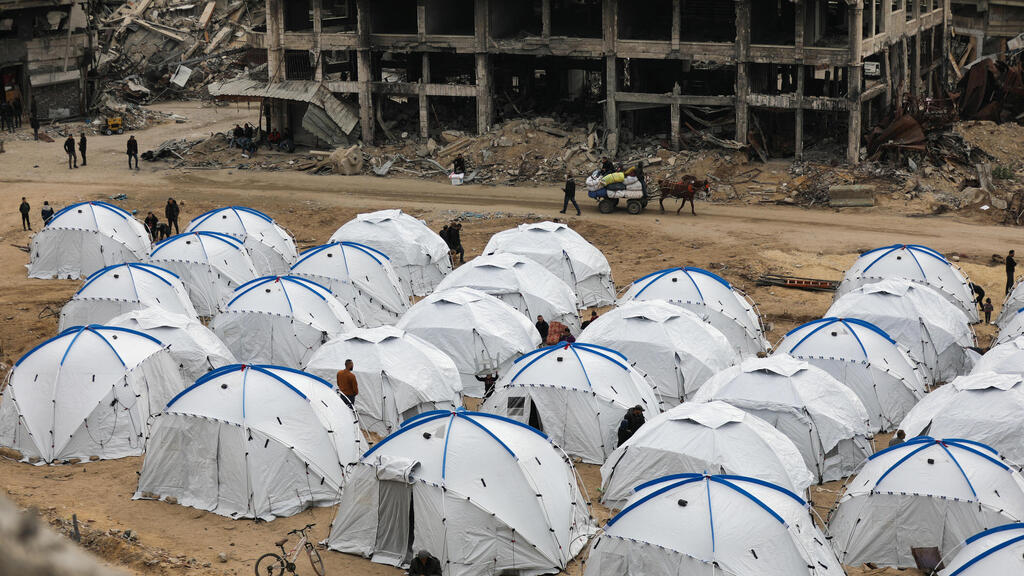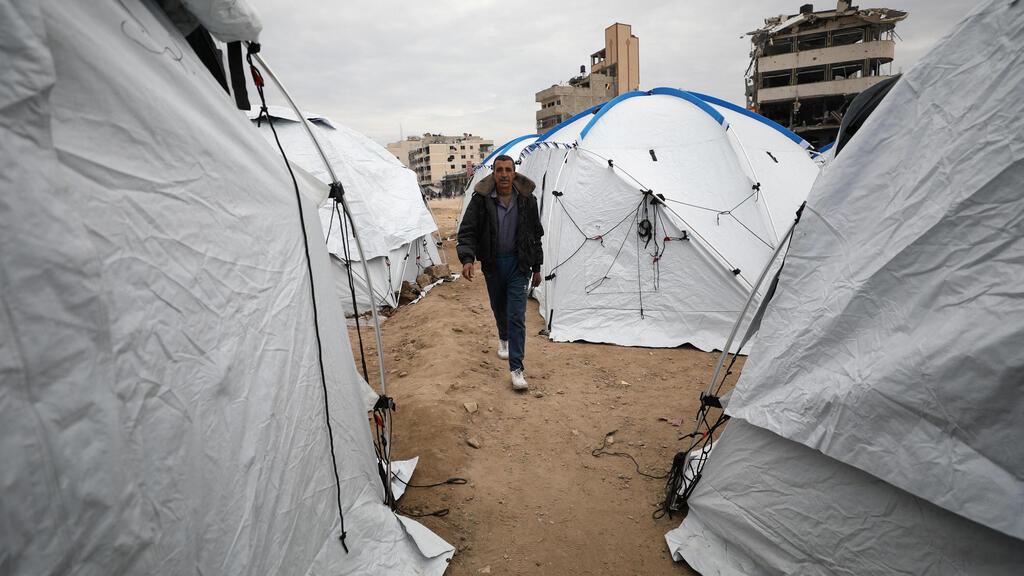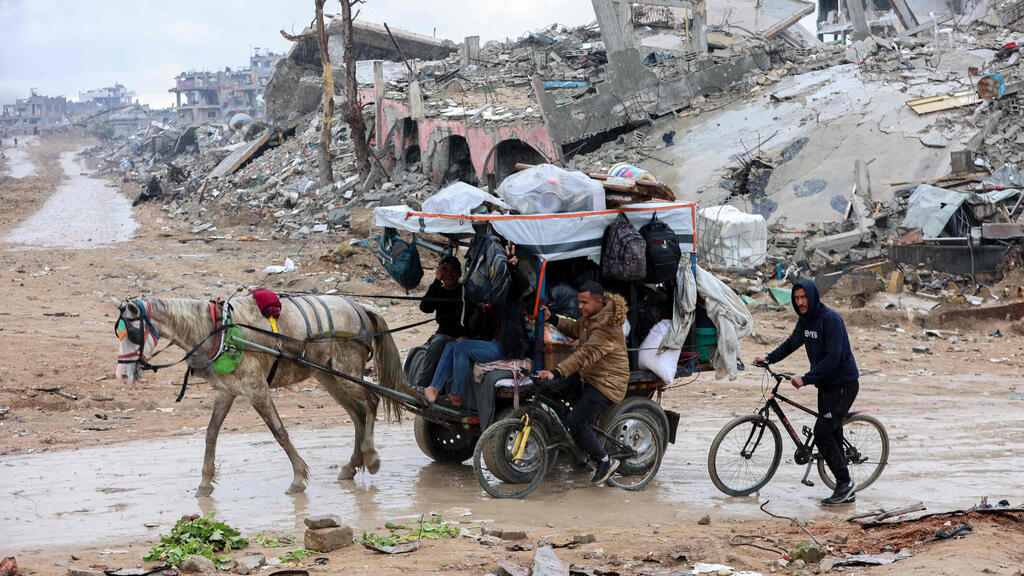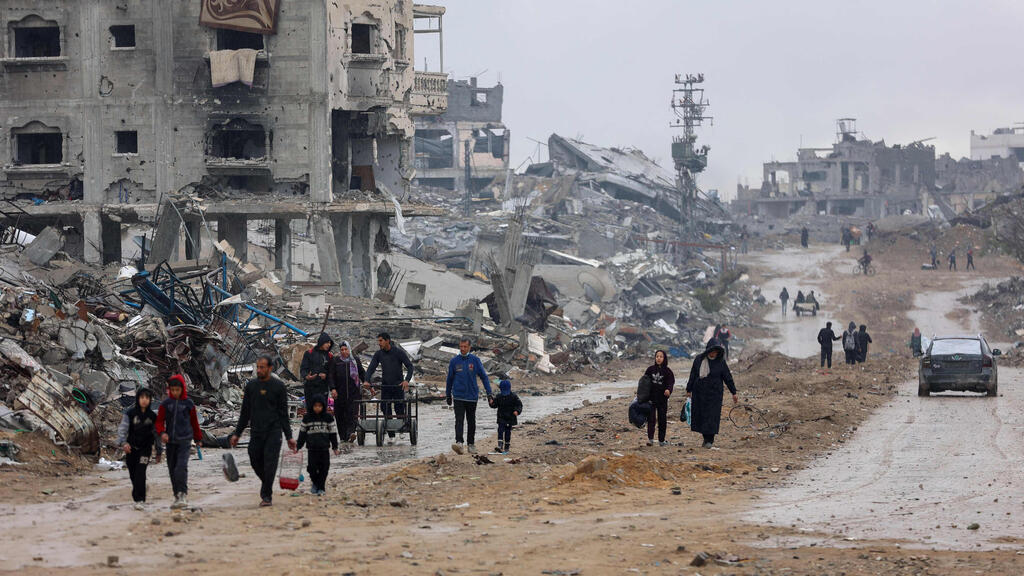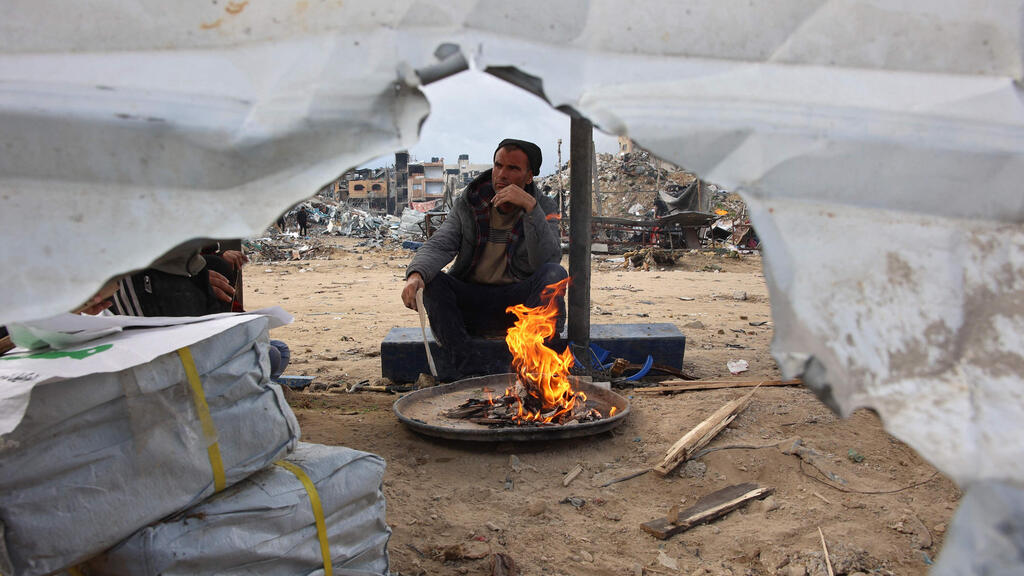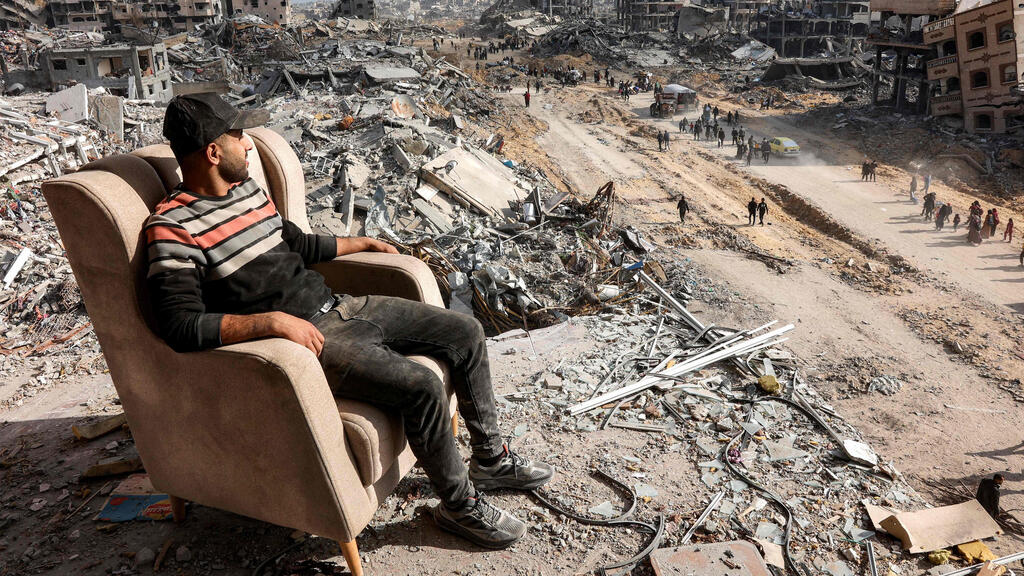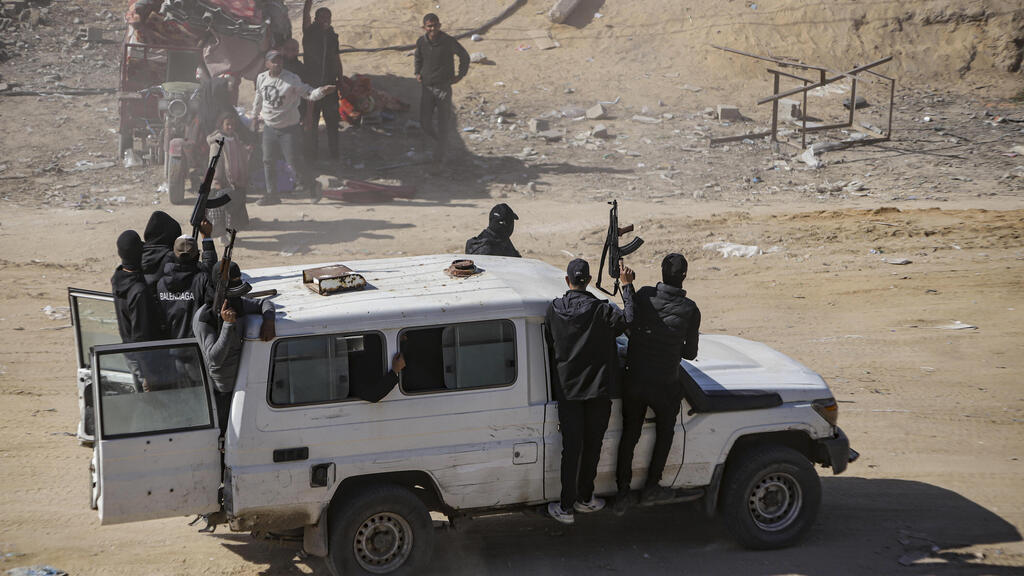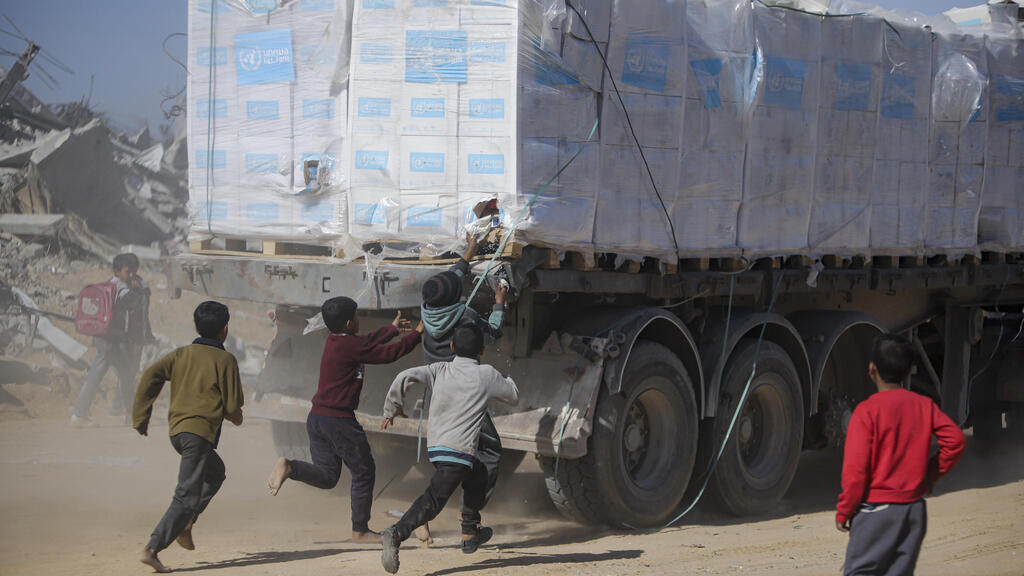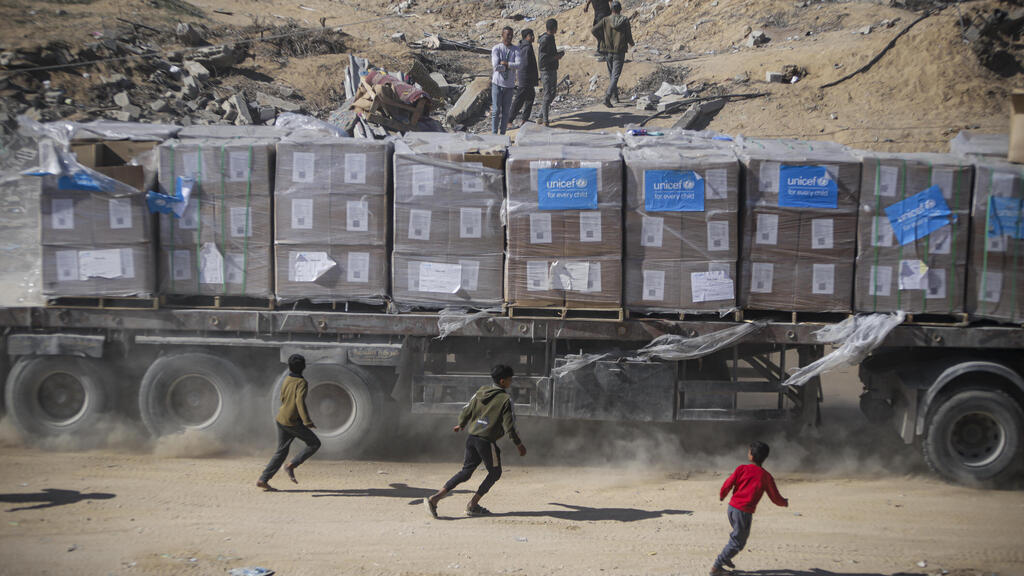Taking over the Netzarim Corridor was one of Israel's significant strategic achievements in the war, but as part of the hostage deal with Hamas the IDF is expected to withdraw on Saturday from the western part of the corridor that bisects the Gaza Strip in its center, thereby enabling the mass return of Palestinian refugees to the northern Strip. In Gaza City, tent camps are already being prepared for the refugees who will return to the ruined city, and the desperation there is evident everywhere.
“Life is very difficult – there's no life, no hope,” Wael Jundiya, one of several who set up a tent complex in an open area of the city, surrounded by ruined buildings, told Reuters. He prepared a tent for his children, who are now staying in the Al-Mawasi humanitarian zone on the coast in southern Gaza, the area where hundreds of thousands of refugees have gathered in the past year. An now, a large part of them are expected to return to the north. Wael is worried that the conditions in the tent will be too difficult and crowded for his family. "Is this the tent that we dreamed of? he asks sarcastically. "Really, is this adequate space?"
The mass influx of refugees into the northern Gaza Strip
(Video: Reuters)
"The tent barely fits two people, and I have eight family members. Each of my children has 5, 6, 7 family members. I used to have a five-story house, it was completely lost, and now after being homeless and suffering for a year and a half, I will live in a tent, with neighbors who hear our voices, and my house exposed to them? Is this the life we dreamed of?" he added.
He demanded that the reconstruction of the Strip be "accelerated."
"This is not a place to live, this is not a place fit for humans." He estimates that the entire complex he and his friends are currently building will only have room for up to 200 people, but "1.5 million people will return from the south, where will they go?"
11 View gallery


Tents set up for displaced Palestinians in their destroyed neighborhoods
(Photo: Omar Al-Qatta/ AFP)
Another Palestinian woman who spoke to Reuters there, Safa Dado, also expressed great frustration: “Our families will return from the south to their blessed land in Gaza City, but they will not find their homes, because they were destroyed by the Zionist occupation. They will find tents that were erected to provide the most basic needs.” She added that “our people will suffer – they have already suffered from the destruction, the bombings and the fear caused by the occupation, and now they will suffer from tragic displacement and tents. The tents will not protect from the cold now or the heat in the summer. This is not a livable situation, but this is what we have now.”
An estimated 2.1 million people now live in the Gaza Strip (a decrease of about 160,000 from the figure before the war began), and the vast majority of them were displaced from their homes at the beginning of the war – while those who fled from the north to the south have not been allowed to return until now via the Netzarim Corridor, a route that the IDF has turned into a real territory with permanent outposts over the past few months.
Now, according to the agreement, the IDF is required to gradually withdraw from the route. On Saturday, in parallel with the implementation of the second phase of the deal in which four hostage women (one civilian and three female IDF observers) will be released in exchange for dozens of terrorists, the IDF will be required to withdraw from the a-Rashid coastal road east of the Salah a-Din road, and dismantle the military installations in the area.
Hamas power and rule: 'We will rebuild every house that is not completely destroyed'
This will begin the return of the displaced Palestinians northward via the same road that crosses the Strip along its length near the Gaza coast. The agreement stipulates that there will be no security checks on those walking – but only on vehicles moving north, checks that will be carried out by a private American company that will cooperate with an Egyptian company.
The U.S. company will send about 100 armed security personnel, most of whom are Americans and some of whom speak Arabic. The security personnel will be from elite units or former CIA personnel. On the 22nd day of the agreement, the withdrawal from the Netzarim Corridor is scheduled to continue and the forces are required to leave the Salah ad-Din Road as well, and dismantle the military installations in this area.
In a statement released Thursday by Hamas ahead of the return of the displaced to the north, it emphasized that it will begin on Saturday after the release of the kidnapped women is completed; Israel expects that the civilian Arbel Yehoud will be one of them. In its statement, Hamas emphasized that refugees returning to the north are not allowed to carry weapons, but no one would be surprised if the terrorist organization tried to violate the terms of the agreement and transfer weapons to the north through covert means.
Hamas, which has been trying to demonstrate its power and governmental capabilities since the ceasefire began on Sunday , including deploying armed police in various areas of the Gaza Strip, is now also trying to present itself as working to help the refugees, and announced that it will help set up tents for those returning to the north.
Senior Hamas official Sami Abu Zuhri told Reuters Thursday that the terror organization is in talks with several Arab countries and "international parties" about helping the refugees return, including providing tents. Abu Zuhri promised that Hamas would immediately begin rebuilding homes that were not completely destroyed. "We are going to invest all our capabilities to help our people. Municipalities have plans in place to welcome the families returning to the north, including setting up tents for them," he said.
There is not a single house standing: 'The smell of dead bodies in the streets'
Hamas spokesman Hazem Qasim claimed Thursday that the expected return of the refugees is an expression of Israel's apparent "failure" in the war, and its attempt, he said, "to uproot the Palestinian people from their lands."
In an interview with the Palestinian news agency Shehab, he added: "The steadfastness and courage of the Palestinian people in Gaza have thwarted Israel's plan to uproot the Palestinian people from their lands. The demands of our people are clear, and they are the right to establish an independent state on the liberated lands. No force will destroy our march toward freedom and independence."
Since the cease-fire began, crowds of refugees already in the north have returned to their neighborhoods – and are shocked by the extensive destruction. In Jabaliya, some are now living right in the rubble, trying to warm themselves on freezing nights around bonfires.
"They are talking about a truce, a cease-fire, and the delivery of aid. It has been three days since we came back, and we cannot find water to drink. We cannot find covers to keep our children warm. We depend on bonfires all night. We wish to have some firewood for the bonfire, we use plastic, which causes diseases," said Mohammed Badr, a father of 10.
His wife, Umm Nidal, said she was still in shock at the destruction in Jabaliya. "There is nothing left, you cannot walk in the streets. Houses collapsed on top of each other. You get lost, you don’t know if this is your home or not," she said. "The smell of dead bodies, and the martyrs are in the streets."
At the same time, in Rafah in the southern Gaza Strip, relatively unusual footage was released Thursday of a gunfight between armed men – whose identities are reportedly unclear – around a humanitarian aid truck that had gotten stuck. According to Reuters, the battle lasted about 10 minutes. In the Rafah area, the Hamas government also claimed Thursday that two Palestinians were killed by Israeli tank fire, and the IDF said that the claims were being investigated.
Gunfight between armed men, around a stuck aid truck
(Video: Reuters)
As part of the deal, Israel allowed a surge in the volume of humanitarian aid flowing into the Gaza Strip – and although according to the agreement the number is supposed to be 600 trucks a day, on Wednesday, according to reports, 897 trucks entered the Gaza Strip. Meanwhile, as part of its attempts to demonstrate its governing capabilities in the Gaza Strip, and thus claim victory over Israel, which promised to destroy the terrorist organization, Hamas also promises to help secure the aid convoys and prevent their looting.
Get the Ynetnews app on your smartphone: Google Play: https://bit.ly/4eJ37pE | Apple App Store: https://bit.ly/3ZL7iNv
"We want to prevent any kind of security vacuum," said Ismail al-Thawbata, director of the Hamas government's communications office in the Gaza Strip. He claimed that about 700 Hamas police officers would help protect the aid convoys, and that since the cease-fire began, not a single truck had been looted - in contrast to the numerous cases of looting and robbery by gangs during the war. A UN spokesman confirmed to Reuters that, as of Tuesday, no cases of looting of aid trucks had been reported.
Al-Thawbata also claimed that, although Israel has eliminated many Hamas operatives throughout the war, it still employs about 18,000 workers "who provide services to civilians on a daily basis," as he put it.




